Clontarf in the Wider World
Published in Features, Issue 2 (March/April 2014), Volume 22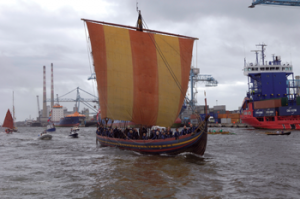
Above: The Viking replica ship Sea Stallion from Glendalough enters Dublin Harbour on 14 August 2007. Both archaeological and historical evidence indicates that Viking Dublin had a wide range of links as a trading emporium. (Verner Karrash, Vikingeskibsmuseet, Roskilde)
Sitric Silkenbeard, king of Dublin, might be turning in his grave if he knew how much historians focus on his arch-rival, Brian. Popular claims that Brian expelled the foreigners from Ireland nearly airbrushed the remainder of Sitric’s reign from popular memory. Nevertheless, Sitric, who came to power in the early 990s, tenaciously held his position in Dublin until 1036, outliving Brian by over two decades. Sitric’s legacy is impressive: he was the first king in Ireland to mint coins in his own name, and poets came from as far afield as Iceland to compose verses in his honour; he went on pilgrimage to Rome; and he is regarded as the founder of Christ Church Cathedral. All that seems to pale into insignificance, however, compared with Brian’s fame. Sitric may be condemned in popular memory to be a loser with a frivolous name.
Sitric’s activities after Clontarf could indicate that business in Viking Dublin carried on as usual, and to foreign eyes the impact of the battle was not so great. A fascinating range of sources reveal, however, that stories about Clontarf excited interest across northern Europe. Evidently the conflict was much more than an internal
squabble between an Irish over-king and some reluctant subjects. To understand this wider circle of interest, it is necessary to review Dublin’s place in the political and economic networks of Viking Age Europe.
Both archaeological and historical evidence indicates that Dublin had a wide range of links as a trading emporium. Brooches, animal skins and slaves were among the goods traded out from the town, while imports included silks, spices and amber. Dublin’s economic success gave it political significance. Across the Irish Sea, Dublin kings were embroiled in affairs in the kingdom of the Isles (including Man and the Hebrides), Britain, Scandinavia and the Continent.
Dublin and the kingdom of the Isles
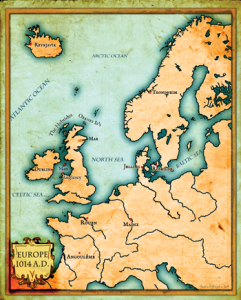 As far back as 980 the men of the Isles had allied with Dubliners to challenge the most powerful king in Ireland. In that year their combined forces marched into Meath to face the Southern Uí Néill over-king, Máel Sechnaill. They suffered a crushing defeat at Tara, which resulted in the sack of Dublin and the abdication of the aged king, Olaf Cuarán. Olaf was succeeded by his son, a half-brother of Máel Sechnaill, who seems to have been willing to work with the Uí Néill over-king rather than against him. Rather than ally with Máel Sechnaill, the Islesmen threw in their lot with the men of Waterford and Brian Boru in a coalition against the Dubliners in 984. The record of this alliance is important, as it shows that Brian Boru was willing to work with Scandinavian rulers. His reign was not one long battle against them. Subsequently, Brian may have extended his influence in the Isles to isolate Dublin. In 1005 Ragnall, king of the Isles, died in Munster. There follows a gap in our knowledge concerning royal succession in the Isles. A claimant to the kingship called Lagmann appears to have been active as a mercenary in Normandy in the early years of the eleventh century. It is possible that Brian ousted him from the throne. Resistance to the interference of the Munster king may have prompted the Islesmen to ally once again with the Dubliners in the run-up to the battle of Clontarf. If Brian did exercise a brief hegemony in the Isles, it could explain the ambitious epithet accorded to him in the Annals of Ulster in 1014—‘over-king of the Gaels of Ireland, and of the Foreigners, and of the Britons’. While it is most unlikely that Brian ruled Wales, the claim could relate to the fact that the Islesmen from time to time sought to extend their sway over Anglesey. Brian may also have sought alliances with Welsh kings, but if so they are lost from the record.
As far back as 980 the men of the Isles had allied with Dubliners to challenge the most powerful king in Ireland. In that year their combined forces marched into Meath to face the Southern Uí Néill over-king, Máel Sechnaill. They suffered a crushing defeat at Tara, which resulted in the sack of Dublin and the abdication of the aged king, Olaf Cuarán. Olaf was succeeded by his son, a half-brother of Máel Sechnaill, who seems to have been willing to work with the Uí Néill over-king rather than against him. Rather than ally with Máel Sechnaill, the Islesmen threw in their lot with the men of Waterford and Brian Boru in a coalition against the Dubliners in 984. The record of this alliance is important, as it shows that Brian Boru was willing to work with Scandinavian rulers. His reign was not one long battle against them. Subsequently, Brian may have extended his influence in the Isles to isolate Dublin. In 1005 Ragnall, king of the Isles, died in Munster. There follows a gap in our knowledge concerning royal succession in the Isles. A claimant to the kingship called Lagmann appears to have been active as a mercenary in Normandy in the early years of the eleventh century. It is possible that Brian ousted him from the throne. Resistance to the interference of the Munster king may have prompted the Islesmen to ally once again with the Dubliners in the run-up to the battle of Clontarf. If Brian did exercise a brief hegemony in the Isles, it could explain the ambitious epithet accorded to him in the Annals of Ulster in 1014—‘over-king of the Gaels of Ireland, and of the Foreigners, and of the Britons’. While it is most unlikely that Brian ruled Wales, the claim could relate to the fact that the Islesmen from time to time sought to extend their sway over Anglesey. Brian may also have sought alliances with Welsh kings, but if so they are lost from the record.
Northern British politics
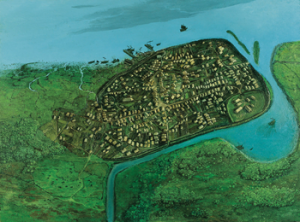
Reconstruction of Dublin c. 1000. (NMI)
Brian’s diplomatic skills may have fostered Scottish involvement in the Battle of Clontarf. Domnall, earl of Mar, fought on Brian’s side at Clontarf, possibly motivated by opposition to the Orcadians, who fought on the other side. Unfortunately Scottish chronicles have not survived to cast light on a northern British perspective. Reference is made in later literary texts to a marriage alliance between the king of Alba, Malcolm II, and the leading dynasties of Leinster and Orkney. These alleged ties did not, however, prompt Malcolm to fight on their side. Nevertheless, the outcome of the battle would have been of interest to the inhabitants of northern Britain.
One figure who looms large in accounts of the Battle of Clontarf is Sigurd, earl of Orkney. Irish sources assign him a prominent place in the list of participants, and in Icelandic sagas Sigurd’s role took on a legend-ary significance. The maritime routes that linked Dublin, the Hebrides and Orkney would naturally have given Sigurd an interest in Irish Sea affairs. According to Icelandic saga accounts, Sigurd fought with the hope of winning the kingdom of Ireland and the mother of Sitric of Dublin, a woman renowned for her beauty and her malicious character. Sitric’s failure is attributed to a supernatural curse, but more of that below.
Scandinavian involvement
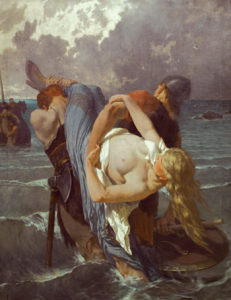
Les pirates Normands au IXe siècle by Évariste-Vital Luminais (1894). Slaves were among the goods traded out from Viking Dublin. (Museé Anne de Beaujeu, Moulin)
In the Annals of Ulster and the Annals of Loch Cé, a Viking called Bródar is called the leader of fleets from Lochlainn (Norway/ Scandinavia). In the Annals of Boyle and the Annals of the Four Masters, Bródar is called leader of the Danair (Danes), although this term might mean Scandinavians in general rather than just people from Denmark. In later accounts Bródar becomes the arch-villain of Clontarf, the slayer of Brian Boru who rejected Christianity and embraced paganism. Later sources also link him with the Isle of Man, but the Irish annals are explicit that his retinue included Scandinavians. As Dublin lies a long way from either Denmark or Norway, Scandinavian involvement in Clontarf should be interpreted in a wider context.
Political developments in Denmark in the late tenth century resulted in centralisation of the power of its kings. Harold Bluetooth, who died c. 986, claimed to have united the Danes and made them Christian, and his reign witnessed an ambitious programme of building fortresses and improving communications. His son Sweinn developed the strategies of his father and is credited with the foundation of urban centres and patronage of the church. Changes in Denmark at this time paved the way for ambitions overseas, and ultimately Sweinn would conquer England.
England had been weakened in 978 by a political coup that saw the murder of a young king, Edward, after a three-year reign, and the accession of a child, his half-brother Aethelred. Soon after, Scandinavian attacks began on southern England. Scandinavian contingents arrived in the Irish Sea in the mid-980s, and are labelled Danair in Irish sources. An alliance quickly developed between some of these fleets and the king of the Isles, who together won a battle against an unnamed enemy in 987. This would be followed by cooperation between the Dubliners and the Scandinavians. In the year 990, an army of the foreigners of Dublin, Scandinavians and Leinstermen combined to attack Meath. Contingents from Dublin may have joined in the Scandinavian raids on England. Coin dies that were probably stolen from mints at Bath, Watchet and Lydford were used to produce some of the earliest coins in Dublin during the 990s. Other booty from England may have been traded through the Dublin markets, providing a welcome economic stimulus.
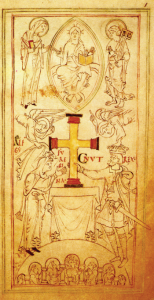
Angels crown King Cnut and his queen, Ælfgifu (Emma), as they present a large gold cross to Hyde Abbey. In a poem attributed to the skald Ottar the Black, Cnut is praised as ‘king of the Danes, the Irish, the English and the island dwellers’.
One of the Scandinavians who may have come to Ireland at this time was the future king of Norway, Olaf Tryggvason. Olaf was an ally of the Danish King Sweinn in the early 990s and they raided England together. Olaf’s arrival in Ireland is reported in the late twelfth-century Norwegian Historia de Antiquitate composed by Theodoric the monk, as well as in a handful of Icelandic sagas. It is claimed that Olaf married Gytha, daughter or sister of the Dublin king, Olaf Cuarán. Chronologically it is more plausible to identify her as a daughter of Olaf and a sister of Sitric Silkenbeard. The record of the marriage has a legend-ary flavour, with Gytha gathering a crowd of suitors and picking out the ill-dressed Norwegian, unaware of his importance. The boundaries between fact and fiction in the record of this marriage are unclear. Nevertheless, in 994 Olaf made a treaty with the English king, Aethelred, and returned to Norway. The agreement would pitch Sweinn, king of Denmark, against Olaf, resulting in Olaf’s defeat and death in 999/1000.
Sweinn’s interest in Irish Sea politics is revealed in his attack on the Isle of Man c. 995 (perhaps to secure influence against Olaf of Norway?). In 1000 the island suffered a further attack by Aethelred of England. This, along with Munster’s involvement in Manx affairs, suggests that control of the western seaways was hotly contested. Sweinn’s attention thereafter focused on England, from which his followers obtained tribute, and in 1013 he won England and was crowned on Christmas Day. Unfortunately for Sweinn, he died five weeks later and the throne was retaken by Aethelred. There must have been a large number of Danish warriors looking for a new field of opportunity in early 1014, and Sitric, king of Dublin, seems to have recruited some to fight at Clontarf.
While Scandinavian troops may have fought for economic gain, political motives may also have played a part. Cnut was not ousted from England until Easter 1014, and had the Dubliners won a great victory in 1014 they might have been in a position to assist the Danish leader. The Norman historian William of Jumieges claims that Cnut before he came to power was allied with a leader called Lagmann, who may have been king of the Isles. It is possible that Cnut encouraged support for the Gaelic-Scandinavian side at Clontarf. Certainly, good relations seem to have flourished between Sitric of Dublin and Cnut after the latter won the English crown in 1016. In a poem attributed to the skald Ottar the Black, Cnut is praised as ‘king of the Danes, the Irish, the English and the island dwellers’. Cnut and Sitric would cooperate closely for the remainder of their reigns in trade and in their policy towards Wales, and would share common ground in religious matters. The implication that Cnut was Sitric’s overlord is not, however, corroborated in other sources and may be poetic hyperbole.
Continental interest
Links between Ireland and the Continent are highlighted in the near-contemporary chronicle of Adémar of Chabannes. Adémar was based at Angoulême, in the Poitou-Charantes region of western France. He records an immense fleet of Vikings from Ireland and Denmark who fought at Clontarf and raided near La Rochelle. Adémar is a rather imaginative writer and his chronology is confused, so one must reluctantly cast doubt on the details of his narrative. He nonetheless shows that news about Clontarf passed to the south-west of France within a decade of the battle. Merchants may have brought stories from Ireland along with their wares. Adémar hints at the alliance between Scandinavians and Dubliners influencing affairs in France. The Annals of Loch Cé and some later sources claim that Normans and Flemings took part in the Battle of Clontarf, fighting against Brian. These are late embellished accounts, however, which may be influenced by the subsequent arrival of Normans and Flemings into Insular politics. The Clontarf story seems to have attracted numerous accretions. News about Clontarf also travelled across the seaways owing to the movements of Irish monks and pilgrims. A significant account of Clontarf is given by Marianus Scotus, an inclusus at Mainz. Writing half a century after the battle, Marianus is the earliest surviving source to declare that Brian Boru was slain while at prayer.
Who won?
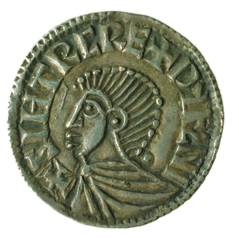
Sitric was the first king in Ireland to mint coins in his own name. (NMI)
While the answer to that question might seem obvious—Brian’s side!—there is a lack of consensus in medieval sources. Irish writers celebrate the battle as a victory for Brian’s side, a fact also recorded by Adémar of Chabannes. Welsh sources are, however, rather ambivalent. For example, the Annales Cambriae merely report that ‘Brian, king of Ireland, and his son, were killed by Sitric king of Dublin’. The death of Brian and the heavy losses incurred on both sides might have allowed a rather over-optimistic interpretation of the battle from a Dublin perspective.
There appear to be conflicting Norse traditions about who won at Clontarf. These can be observed in two thirteenth-century Icelandic literary masterpieces, Njál’s Saga and Orkneyinga Saga. Njál’s Saga tells of a man called Darra∂ who had a vision in Caithness on the day of the battle. He saw twelve women weaving, using a sword and arrows instead of shuttle and reels; the loom was weighted with men’s heads, and the threads were human entrails. The song that these supernatural women sing is given in poetic form, which probably pre-dates the surrounding prose. According to their song, it is the Irish who will never recover from the grief of the battle, and although the earl dies, it is the young king who wins. Sitric in 1014 was roughly 40 years younger than Brian, although still middle-aged. The contrasting views of the battle in the poem and the surrounding prose have led some commentators to question whether the right battle is referred to. Elsewhere in Njál’s Saga the victory of the saintly King Brian receives tremendous praise.
There are other hints, however, that tales of a Dublin victory circulated orally before the thirteenth century. In Orkneyinga Saga we are told that the mother of Sigurd of Orkney had magical powers and that she wove for her son a banner embroidered with the figure of a raven. Whoever carried the banner would die, but the army before which it was carried would win. The effectiveness of the banner is tried out in a battle with the Scots; then Sigurd takes the banner to Ireland and fights at Clontarf. When Sigurd’s men see standard-bearer after standard-bearer fall, they refuse to carry it. Orkneyinga Saga states that then ‘the earl bore it himself, and fell there but king Sitric fled. King Brian fell with victory and glory.’ It seems a little tough on Sigurd that his mother’s magic only half-worked, and could suggest that the story harks back to an earlier tradition that Sigurd’s side won even though he died. The point of prophecies and magic in medieval fictions is that they are supposed to work. Njál’s Saga may rationalise the supernatural blunder by adding the detail that when Sigurd took up the banner he hid it under his shirt—in other words, he failed to bear it before the troops and so lost the victory.
A divergent Norse tradition of the outcome of Clontarf is also found in the early twelfth-century Gesta Herewardi. This saga, which drew on oral legends from the English Danelaw, contains (as Lenore Fischer has recently highlighted) a garbled account of Clontarf. In this, Hereward and his ally Sitric win the battle against the king of Munster. Although the Gesta is extremely fanciful, it seems to reflect a lost tradition that Sitric won at Clontarf. The truth of the Irish victory would, how-ever, be recognised by Norse commentators in the thirteenth century and later. The portrayal of the victorious King Brian in Icelandic sagas is just as saintly as that known to Irish literature. Norse perceptions seem to have shifted following the composition of the famous Irish saga Cogadh Gáedhel re Gallaibh (‘The war of the Irish against the Foreigners’). The similarities between the Cogadh and the Icelandic saga accounts are strong and suggest that tales from the former circulated in a Norse cultural milieu. Norse traditions of Clontarf appear to have been re-invigorated by stories from Ireland, showing a continued interest in Irish affairs. These tales were incorporated into some of the most famous works of Icelandic literature. The fact that the Battle of Clontarf excited such interest is eloquent witness to its wider place in northern European history and culture.
Clare Downham is a senior lecturer in Irish Studies at the University of Liverpool.
Further reading
C. Downham, ‘England and the Irish Sea zone in the eleventh century’, Anglo-Norman Studies 26 (2003), 55–73.
S. Duffy, Brian Boru and the Battle of Clontarf (Dublin, 2013).
C. Etchingham, ‘North Wales, Ireland and the Isles: the Insular Viking zone’, Peritia 15 (2001), 145–87.
M. Ní Mhaonaigh, Brian Boru: Ireland’s greatest king? (Stroud, 2007).
















